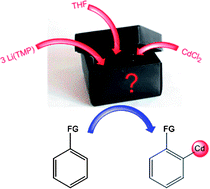Designed to remove some of the mystery surrounding mixed-metal TMP (2,2,6,6-tetramethylpiperidide) metallating reagents, this study examines in detail “LiCd(TMP)3” in its own right. Previously established as an excellent “cadmating” (Cd–H exchange) reagent towards a wide variety of aromatic substrates, “LiCd(TMP)3” has been investigated by 1H, 13C and 113Cd NMR studies as well as by DOSY NMR spectroscopy. This evidence puts a question mark against its ate formulation implying it exists in THF solution as two independent homometallic amides. Exploring the reactivity of “LiCd(TMP)3” with anisole as a test substrate, both experimentally by NMR studies and theoretically by DFT studies suggests a two-step lithiation/transmetallation process in which the initially formed ortho-lithiated species undergoes a reaction with Cd(TMP)2 to form new Cd-C and Li–N bonds. For completeness, the homometallic cadmium component Cd(TMP)2 has been comprehensively characterised for the first time including a crystal structure determination revealing a near-linear N–Cd–N arrangement.

You have access to this article
 Please wait while we load your content...
Something went wrong. Try again?
Please wait while we load your content...
Something went wrong. Try again?


 Please wait while we load your content...
Please wait while we load your content...